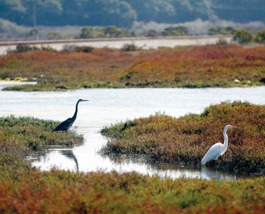home | metro santa cruz index | news | santa cruz | news article

Photograph by Curtis Cartier
Port Heron: Waterfowl and other wildlife call Elkhorn Slough home in spite of its problems.
Elkhorn Slough's Troubled Waters
A new report on sanctuary health rates the estuary the most threatened part of Monterey Bay.
By Curtis Cartier
AS THE midmorning sun burns off the hazy remnants of fog over Elkhorn Slough, the estuary comes to life in the same way it has for thousands of years. Herons glide low over the top of the chilly water, otters scoop up clams from the floor and each step along the reed-edged hiking path sends an unseen critter scuttling loudly into the brush. A visitor might find it hard to believe that, according to a recent report by the National Oceanic and Atmospheric Administration, this is the most damaged ecosystem in the Monterey Bay National Marine Sanctuary.
"It's true, Elkhorn Slough has the most environmental concerns of anywhere in the sanctuary," says Kerstin Wasson, research coordinator with Elkhorn Slough National Estuarine Research Reserve and the principal author of the NOAA report's Elkhorn Slough assessment. "[Elkhorn Slough] and the surrounding area has some of the highest nutrient levels to be found. The major problems are pollution, invasive species and hydrological alterations."
Located about eight miles south of Watsonville, Elkhorn Slough serves as the drainage delta for the Salinas River and countless tributary streams that worm through the surrounding farmland. A rich landscape that supports more than 300 bird species and countless fish and mammals, alongside a large portion of Monterey County's $3 billion-per-year berry industry, the bountiful soil is prime real estate for both humans and wildlife.
The first of its kind for Monterey Bay National Marine Sanctuary, this "condition report," released Oct. 1, was compiled by the NOAA with help from Monterey Bay Aquarium Research Institute and the Office of National Marine Sanctuaries. Researchers hope it is the first in what will be a yearly rating of the sanctuary's overall health when it comes to water quality, animal habitat, biodiversity and ocean floor archaeology.
The report generally gave high marks to every other part of the protected coastline and ocean in the 6,100-square-mile sanctuary, which extends from Mill Valley, north of San Francisco, south along 276 miles of coastline to Cambria. Yet it paints a disturbing portrait of Elkhorn Slough, citing poor water quality, "severe reductions" in native animals and plants, "substantial erosion" and a "high percentage of non-native species."
Mark Silberstein, executive director of the Elkhorn Slough Foundation, says that the environmental damage identified in the recent report is nothing new. He contends that, through his decades-long career at the slough, he has actually seen conditions steadily improve, and that the report may portray an "unfair snapshot" of the wetland.
"Elkhorn Slough has some major problems," he says, tracing a finger along a topographical map of the estuary. "But if you had seen the data from 10 or 20 years ago, you'd see we've come a long way."
Swamp Boogie
Problems at Elkhorn Slough begin with the tides. Twice a day, the fresh water that flows into the estuary is sucked out to sea with the draining tide. A few hours later, the tides return and send whatever water is left in the basin rushing violently upstream. The dredging and widening of the Salinas River that made the Moss Landing harbor possible is also responsible for the fierceness of the tides that are now blamed for stripping away the precious salt marshes and mud flats of the slough. Additionally, water from the Salinas River--water loaded with fertilizers and pesticides--collects in the harbor during low tide and is pushed upstream and distributed throughout the slough's waterways when the tides return.
John Haskins, a water quality specialist at the reserve, says this phenomenon is a one-two punch on the environment.
"You've got the Salad Bowl of the U.S. draining into the harbor, then being pushed up into every part of the estuary," he says. "It's water quality, I believe, that's the biggest problem facing the reserve right now."
Farmers in the area are used to having fingers pointed at them when it comes to environmental concerns. They argue, however, that the amount of fertilizer and pesticides they use is negligible, and that farming practices on the Central Coast are the most environmentally friendly in the country.
"These days the profit margins are so slim that you can only use the bare minimum of fertilizer and pesticides if you want to turn a profit," says Mark Munger, vice president of Marketing for Sundance Berry Farms, a national chain with a strawberry farm a few miles from Elkhorn Slough.
Whether the farmers are to blame or not, every expert interviewed by Santa Cruz Weekly maintains that there is no "silver bullet" when it comes to improving conditions at Elkhorn Slough. They say environmentally conscious farming practices--which include planting wild grasses between crop fields and runoff streams--will need to combine with a yearly detection program for invasive species, added restrictions on water use for surrounding residents and farmers, and a rebuilt Salinas River mouth that's more natural, so as to tame the violent tides. Only then can this diverse ecosystem end its reign as the problem child of Monterey Bay.
Send a letter to the editor about this story.
|
|
|
|
|
|